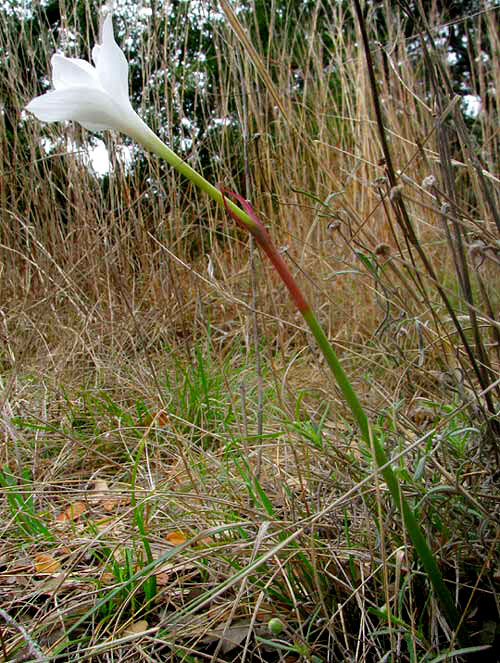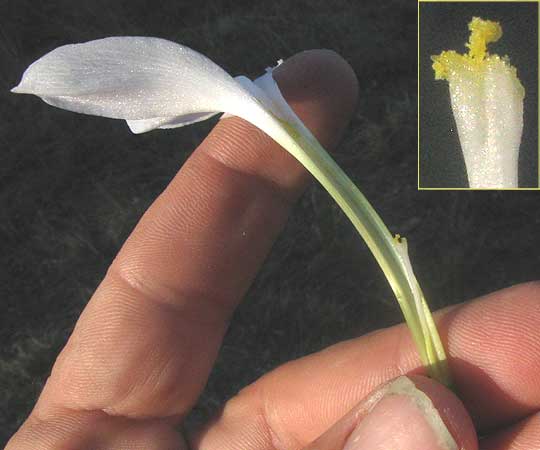Excerpts from Jim Conrad's
Naturalist Newsletter
from the April 14, 2013 Newsletter issued from the Frio Canyon Nature Education Center in northern Uvalde County, southwestern Texas, on the southern border of the Edwards Plateau; elevation ~1750m (~5750 ft); N29.62°, W99.86°; USA
RAIN LILIES FLOWERING
It rained a bit last week, so early this week the Rain Lilies were up, as shown below:

At first I thought this was the same species that flowered en masse after a big rain last September, but gradually I began noticing little differences. This spring's plants seemed a bit larger than last September's and they tended to grew several feet apart while the ones last year were more likely to grow close together. This spring's plants occur mostly in grassy spots on lower, rocky slopes of limestone hills, while last year's plants occurred on the valley floor, often in disturbed soil.
So, here we have two Rain Lily species to deal with. Last September's Rain Lily was Zephyranthes chlorosolen, which you can review at http://www.backyardnature.net/n/h/rainlily.htm.
The Rain Lily flowering now is the closely related ZEPHYRANTHES DRUMMONDII.
Besides being larger in nearly every respect, this spring's Zephyranthes drummondii displays field marks that separate it from the smaller Z. chlorosolen, and you can see them below:

There I've broken open a blossom. At the corolla tube's base, the slender item leaning out of the open tube is the ovary neck, or style, at the top of which is a three-parted stigma. The inset at the picture's upper right shows the stigma with its three stigma lobes looking like white, vertically held, thick fingers. The yellow gob at the very top of the stigma is a bunch of pollen left by a pollinator, not part of the stigma. Thing is, the smaller Rain Lily's style is relatively much longer, extending to the tube's opening. Also, the smaller Rain Lily's stigma is not three-lobed, but rather "capitate," or like a balled fist.
In your own wildflower book, if you look up our currently blooming Rain Lily, Z. drummondii, the older name, Cooperia pedunculata, may be used. It may also go by any of several common names, such as Texas Rainlily, Hill Country Rainlily, Evening Rain Lily, Prairie Lily, Thunder Lily and more. Rain lilies are currently placed in the Lily Family, though in the past sometimes they resided in the Amaryllis Family.
from the August 11, 2013 Newsletter issued from the Frio Canyon Nature Education Center in the valley of the Dry Frio River in northern Uvalde County, southwestern Texas, on the southern border of the Edwards Plateau; elevation ~1750m (~5750 ft); N29.62°, W99.86°; USA
RAIN-LILY PODS FILLED WITH BLACK SEEDS
In grassy prairie patches at the edge of limestone cliffs overlooking the Dry Frio River nowadays you run across green, herbaceous, leafless, foot-tall stems rising from the ground, topped with items like those shown below:

These are fruiting pods of rain lilies. The one at the right is so immature that not only has it not split apart but also still is in the process of bursting through and casting off the remains of the former flower's corolla-like perianth. The capsule at the left has matured and opened so widely that black seeds lie in the capsule's three chambers, or "locules." The seeds have lost all connections to the plant body so a nice breeze or the merest touch of the stem sends them flying. A rabbit running into such an open pod would scatter seeds for several feet, which is exactly what the plant wants.
We've documented two very similar rain lily species here, Zephyranthes drummondii and Zephyranthes chlorosolen. I'm unsure which species this is, though I know that in this area Zephyranthes drummondii was flowering in the spring, so I'm guessing that that's what we have. The other species' capsules and seeds wouldn't look much different.